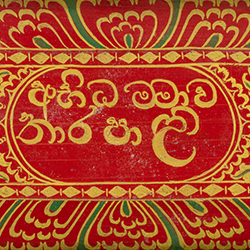Pali Manuscripts

The John Rylands Research Institute and Library holds over seventy manuscripts from Sri Lanka within its special collections, all of which date from the 17th to the 19th century. Many of these manuscripts are written in the Pali language – which gives the collection its name.
While the collection includes a small number of paper codices, most of its manuscripts are written on palm leaves. Palm-leaf collections such as these record important Buddhist scripture, in addition to early indigenous knowledge of medicine, literature, agriculture, astrology, and the arts. They are the primary historical sources that chronicle the linguistic, cultural, and technological development of Sri Lanka and its people and are of both anthropological and theological value.
The John Rylands Research Institute and Library, Paramaththa, and the International Centre for Theravada Buddhism UK (ICTB UK) have partnered to digitise thirty-two of the Rylands Pali Manuscripts and make them freely available online. This digitised special collection contains a selection of twenty-one palm leaf manuscripts from the library’s physical collection of seventy Pali items. With one exception, all the digitised manuscripts originate from Sri Lanka.
Rare Buddhist manuscripts
The Pali Manuscripts collection primarily concerns Theravada Buddhism, one of the two major schools of Buddhist practice, which is found throughout Sri Lanka, Thailand, and Myanmar (formerly Burma). The collection holds a significant number of manuscripts attributed to the Theravada canon and many have been published by the Pali Text Society. The library holds exceptionally complete manuscripts of the Paṭṭhānappakarana (Pali MS 5) and Nettipakaraṇa (Pali MS 7), which are rare even in Sri Lanka.
Languages found within the collection
The Pali Manuscripts collection at the Rylands is largely written in the Pali language using Sinhalese script. However, it also contains manuscripts that are in the Burmese and Sinhalese languages, with some written in Burmese (Pali MS 1) and Cambodian (Khmer) script (Pali MS 82). All of the items included in this digital special collection are written in Sinhalese characters, except for Pali MS 64, which is written in Burmese characters.
How the Pali collection came to be at the Rylands
The majority of items in the Rylands Pali Manuscripts collection were presented to the Library in 1915 by Thomas William Rhys Davids (1843-1922), professor of comparative religion at the University of Manchester, who founded the Pali Text Society. Some manuscripts are unusually complete copies that were made expressly for Rhys Davids by Sri Lankan scholars. Amongst these are a large number copied by Edmund Rowland Gooneratne (1845-1914), the Ceylonese writer, administrator, and Honorary Secretary of the Pali Text Society. Other manuscripts were bought by Rhys Davids or were received as presents from monasteries. We have only partial information about the earlier provenance of such manuscripts in the collection and the library is, therefore, actively engaged in further research to determine more about their origins. Records for the manuscripts will continue to be updated, as further provenance information comes to light.
If you have any additional information you would like to share about the items in this collection, please email the curator (Zsofia Buda). For additional information the Pali manuscripts collection, please visit our Pali manuscripts webpage or consult N.A. Jayawickrama’s catalogue (1972).




